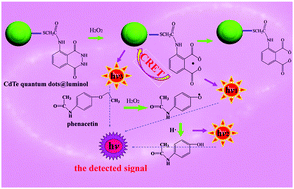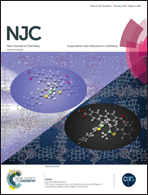CdTe quantum dots@luminol for trace-level chemiluminescence sensing of phenacetin based on biological recognition materials
Abstract
A trace-level chemiluminescent (CL) sensor for the determination of phenacetin, utilising CdTe quantum dots@luminol (QDs@luminol) for signal amplification, based on a chitosan/magnetic graphene oxide-molecularly imprinted polymer (CsMG-MIP) as a biological recognition material was fabricated. CdTe QDs@luminol, which was used in the preparation process for the sensor, could amplify the signal of the CL sensor through chemiluminescence resonance energy transfer (CRET) while reducing the consumption of luminol. The CsMG-MIP, taking full advantage of the abundant hydroxyl and amino groups in chitosan which provide a lot of sites for the formation of hydrogen bonds in SMIP, using graphene oxide to improve the adsorption capacity and Fe3O4 nanoparticles to make the preparation of the recognition unit simple and easy, was introduced into the CL sensor. Under the optimized conditions of the CL sensor, phenacetin could be assayed in the range of 3.0 × 10−9–3.0 × 10−7 mol L−1 with a detection limit of 8.2 × 10−10 mol L−1 (3δ). With the advantages of amplifying the CL signal through CRET and reducing the consumption of luminol simultaneously, the sensor was successfully applied to the determination of trace-level phenacetin in real samples with a high selectivity and with the reagent economized.


 Please wait while we load your content...
Please wait while we load your content...